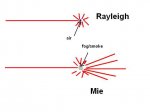Ok, been lurking around wikipedia
and got to sum all this up,
it is VERY interesting if you ask me, and has a simple explanation. If you want to know why we perceive the sky as blue, read on!
(Note: The important processes in the atmosphere (Rayleigh scattering and Mie scattering) are elastic. No energy transformation results, only a change in the spatial distribution of the radiation.)
Simpler explanation (better one (IMO) below): When one looks at the sky during the day, rather than seeing the black of space, one sees light from Rayleigh scattering off the air. Rayleigh scattering is inversely proportional to the fourth power of wavelength, which means that the shorter wavelength of blue light will scatter more than the longer wavelengths of green and red light. This gives the sky a blue appearance. Conversely, when one looks towards the sun, one sees the colors that were not scattered away - the longer wavelengths such as red and yellow light. When the sun is near the horizon, the volume of air through which sunlight must pass is significantly greater than when the sun is high in the sky. Accordingly, the gradient from a red-yellow sun to the blue sky is considerably sharper at sunrise and sunset.
Better (IMO) explanation:
The sunlit sky appears blue because air scatters short-wavelength light more than longer wavelengths. Since blue light is at the short wavelength end of the visible spectrum, it is more strongly scattered in the atmosphere than long wavelength red light. The result is that the human eye perceives blue when looking toward parts of the sky other than the sun. Near sunrise and sunset, most of the light we see comes in nearly tangent to the Earth's surface, so that the light's path through the atmosphere is so long that much of the blue and even green light is scattered out, leaving the sun rays and the clouds it illuminates red.
and got to sum all this up,
it is VERY interesting if you ask me, and has a simple explanation. If you want to know why we perceive the sky as blue, read on!
(Note: The important processes in the atmosphere (Rayleigh scattering and Mie scattering) are elastic. No energy transformation results, only a change in the spatial distribution of the radiation.)
Simpler explanation (better one (IMO) below): When one looks at the sky during the day, rather than seeing the black of space, one sees light from Rayleigh scattering off the air. Rayleigh scattering is inversely proportional to the fourth power of wavelength, which means that the shorter wavelength of blue light will scatter more than the longer wavelengths of green and red light. This gives the sky a blue appearance. Conversely, when one looks towards the sun, one sees the colors that were not scattered away - the longer wavelengths such as red and yellow light. When the sun is near the horizon, the volume of air through which sunlight must pass is significantly greater than when the sun is high in the sky. Accordingly, the gradient from a red-yellow sun to the blue sky is considerably sharper at sunrise and sunset.
Better (IMO) explanation:
The sunlit sky appears blue because air scatters short-wavelength light more than longer wavelengths. Since blue light is at the short wavelength end of the visible spectrum, it is more strongly scattered in the atmosphere than long wavelength red light. The result is that the human eye perceives blue when looking toward parts of the sky other than the sun. Near sunrise and sunset, most of the light we see comes in nearly tangent to the Earth's surface, so that the light's path through the atmosphere is so long that much of the blue and even green light is scattered out, leaving the sun rays and the clouds it illuminates red.






